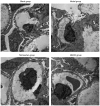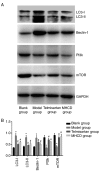Modified Huangqi Chifeng decoction inhibits excessive autophagy to protect against Doxorubicin-induced nephrotic syndrome in rats via the PI3K/mTOR signaling pathway
- PMID: 30210600
- PMCID: PMC6122515
- DOI: 10.3892/etm.2018.6492
Modified Huangqi Chifeng decoction inhibits excessive autophagy to protect against Doxorubicin-induced nephrotic syndrome in rats via the PI3K/mTOR signaling pathway
Abstract
The aim of the present study was to investigate whether modified Huangqi Chifeng decoction (MHCD) could be an effective treatment against Doxorubicin-induced nephrosis in rats and whether it regulates autophagy via the phosphoinositide-3 kinase/mammalian target of rapamycin (PI3K/mTOR) signaling pathway. A total of 40 male Sprague-Dawley rats were randomly divided into blank, model, telmisartan and MHCD groups. The rat model of nephrosis was induced by intragastric administration of Doxorubicin for 8 weeks. Rats were housed in metabolic cages and urine was collected once every 2 weeks to measure 24-h protein levels. Blood samples were obtained from the abdominal aorta and levels of albumin (ALB), total cholesterol (TCH), triacylglyceride (TG) and serum creatinine (Scr) were assessed. Renal pathological changes were examined using hematoxylin-eosin, Masson's trichome and periodic acid-Schiff staining. Podocytes and autophagosomes were observed using an electron microscope. The expression and distribution of microtubule-associated proteins 1A/1B light chain 3B (LC3), LC3-I, LC3-II, beclin-1, PI3K and mTOR were determined using immunohistochemistry and western blotting. At weeks 6 and 8, 24-h proteinuria significantly decreased in the MHCD group compared with the model group (P<0.05). Compared with the model group, the MHCD group exhibited significantly reduced levels of TG, TCH and Scr, as well as significantly increased ALB levels (P<0.05). MHCD was demonstrated to prevent glomerular and podocyte injury. The number of autophagosomes was significantly decreased and the expression of beclin-1, LC3, LC3-I and LC3-II was inhibited following MHCD treatment compared with the model group (P<0.05). MHCD treatment significantly increased the expression of PI3K and mTOR in Doxorubicin nephrotic rats compared with the model group (P<0.05). In conclusion, MHCD was demonstrated to ameliorate proteinuria and protect against glomerular and podocyte injury by inhibiting excessive autophagy via the PI3K/mTOR signaling pathway.
Keywords: Chinese herbal medicine; Doxorubicin-induced nephrotic rats; autophagy; mammalian target of rapamycin; phosphoinositide-3 kinase.
Figures








Similar articles
-
Protective effect of modified Huangqi Chifeng decoction on immunoglobulin A nephropathy through toll-like receptor 4/myeloid differentiation factor 88/nuclear factor-kappa B signaling pathway.J Tradit Chin Med. 2024 Apr;44(2):324-333. doi: 10.19852/j.cnki.jtcm.20240203.001. J Tradit Chin Med. 2024. PMID: 38504538 Free PMC article.
-
Ameliorative effects of Modified Huangqi Chifeng decoction on podocyte injury via autophagy mediated by PI3K/AKT/mTOR and AMPK/mTOR pathways.J Ethnopharmacol. 2024 Mar 1;321:117520. doi: 10.1016/j.jep.2023.117520. Epub 2023 Dec 1. J Ethnopharmacol. 2024. PMID: 38042389
-
Modified Huangqi Chifeng Decoction Attenuates Proteinuria by Reducing Podocyte Injury in a Rat Model of Immunoglobulin a Nephropathy.Front Pharmacol. 2021 Jul 26;12:714584. doi: 10.3389/fphar.2021.714584. eCollection 2021. Front Pharmacol. 2021. PMID: 34381367 Free PMC article.
-
Danshen injection induces autophagy in podocytes to alleviate nephrotic syndrome via the PI3K/AKT/mTOR pathway.Phytomedicine. 2022 Dec;107:154477. doi: 10.1016/j.phymed.2022.154477. Epub 2022 Sep 25. Phytomedicine. 2022. PMID: 36215790
-
Modified Huangqi Chifeng decoction alleviates podocyte injury on rat with experimental membranous nephropathy.Ren Fail. 2025 Dec;47(1):2459896. doi: 10.1080/0886022X.2025.2459896. Epub 2025 Feb 19. Ren Fail. 2025. PMID: 39972601 Free PMC article.
Cited by
-
Exploring the therapeutic mechanism of Yuebi decoction on nephrotic syndrome based on network pharmacology and experimental study.Aging (Albany NY). 2024 Sep 20;16(18):12623-12650. doi: 10.18632/aging.206116. Epub 2024 Sep 20. Aging (Albany NY). 2024. PMID: 39311772 Free PMC article.
-
Protective effect of modified Huangqi Chifeng decoction on immunoglobulin A nephropathy through toll-like receptor 4/myeloid differentiation factor 88/nuclear factor-kappa B signaling pathway.J Tradit Chin Med. 2024 Apr;44(2):324-333. doi: 10.19852/j.cnki.jtcm.20240203.001. J Tradit Chin Med. 2024. PMID: 38504538 Free PMC article.
-
Morroniside Inhibits H2O2-Induced Podocyte Apoptosis by Down-Regulating NOX4 Expression Controlled by Autophagy In Vitro.Front Pharmacol. 2020 Sep 23;11:533809. doi: 10.3389/fphar.2020.533809. eCollection 2020. Front Pharmacol. 2020. PMID: 33071778 Free PMC article.
-
VEGFA promotes the occurrence of PLA2R-associated idiopathic membranous nephropathy by angiogenesis via the PI3K/AKT signalling pathway.BMC Nephrol. 2022 Sep 16;23(1):313. doi: 10.1186/s12882-022-02936-y. BMC Nephrol. 2022. PMID: 36114523 Free PMC article.
-
Traditional Chinese Medicine in Treating Primary Podocytosis: From Fundamental Science to Clinical Research.Front Pharmacol. 2022 Aug 8;13:932739. doi: 10.3389/fphar.2022.932739. eCollection 2022. Front Pharmacol. 2022. PMID: 36003509 Free PMC article. Review.
References
-
- Barnett AH, Bain SC, Bouter P, Karlberg B, Madsbad S, Jervell J, Mustonen J, Diabetics Exposed to Telmisartan and Enalapril Study Group Angiotensin-receptor blockade versus converting-enzyme inhibition in type 2 diabetes and nephropathy. N Engl J Med. 2004;351:1952–1961. doi: 10.1056/NEJMoa042274. - DOI - PubMed
-
- Gong XZ, Zhou LF, Wang Q, Tang XC, Qian YR, Wang YR, Lu L, Zhou JJ. Effect of Chuanhuang No.1 recipe on renal function and micro-inflammation in phase 3 chronic kidney disease patients. Zhongguo Zhong Xi Yi Jie He Za Zhi. 2015;35:137–141. (In Chinese) - PubMed
LinkOut - more resources
Full Text Sources
Other Literature Sources
Miscellaneous
